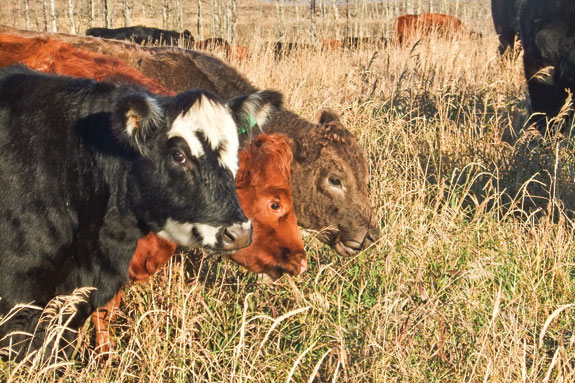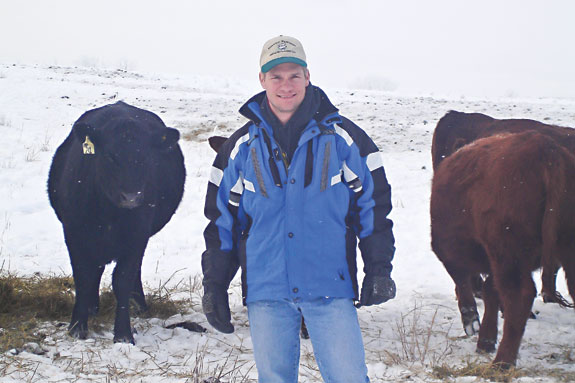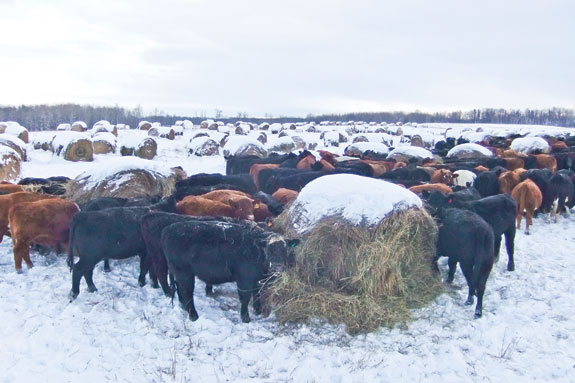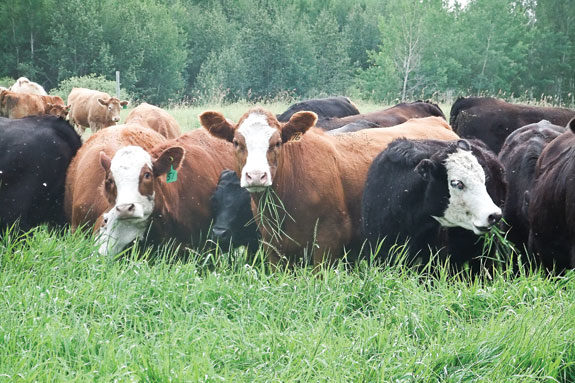Kenyon doesn’t own a tractor. He doesn’t own a ranch.
He rents approximately 2,500 acres of pasture, provides custom grazing service for around 1,000 head of cattle, but still insists that his real job is to raise three children.
At a December seminar with 60 Manitoba cattlemen, Kenyon described a ranching business that’s been growing for 15 years.
For the past seven years, his company (Greener Pastures Ranching Ltd.) has conducted winter seminars as well as providing custom grazing services.
“I’ve never owned a tractor,” Kenyon said in a telephone interview. “I do have bale trucks and a portable corral system.”

A bale truck is “much quicker” than a tractor, he said. His current truck has hydraulic arms and can handle two round bales at a time.
It’s handy for traveling down the pastures. He admits it could use more clearance and needs more frequent repairs than a tractor.
Greener Pastures also offers grazing service for winter. Last winter, Kenyon dormant-season grazed and bale-grazed 365 bred heifers out in the pastures.
Most pastures have at least 20 paddocks. Kenyon applies intensive self-management, and cell grazing, for the growing season.
“I like to move my yearlings every day in spring. In summer, I try to move them every two or three days,” he said. “I want less stress on the calves, so at first I probably move the cows every two or three days, and then every five or six days in summer.”
Moving a herd to a new paddock is easy after they’ve learned the idea. The key is to move them gently and leave lots of residue.
“If they know they’re getting new grass when you show up, they’re pretty eager to come see what you’re doing; if you’re too late, then they come pretty fast!”
May and June are the most intensive management months. During that period, he’s training the herds, checking fences and setting up watering systems.
He may travel by truck between pastures, but in the pastures he’s on foot or driving an ATV. Grazing and fence management work best for him with a quad or on foot.
The horse is used for treating animals on pasture; however, very few treatments are needed in Kenyon’s program.
“My land has a lot of bush, so you’re walking through bush to check fence,” he said.
His summer hours shorten to about six a day.
“The majority of my business is the summer grazing. I take it as late as possible into the dormant season.

The latest I’ve ever grazed dormant-season grass is into the middle of February. I can usually hit November-December.”
The first custom-grazed yearlings start going home in September. Meanwhile, Kenyon has been preparing for off-season grazing.
He has been purchasing crop residue, salvaging grain crops for swath- grazing and collecting hay for winter bale-grazing.
Grazing options
During the first part of the dormant season, he can move herds into paddocks with stockpiled grass from summer grazing.
Sometimes, bunch-grazing is a late-fall option. It involves turning a herd into combine residue piles across a grain field or swaths.
For early winter, swath-grazing is a good option. “Ideally, with the snowfall we get, I’d love to see swath- grazing until sometime in January. I’ve never had any wrecks before then,” he said.
However, access isn’t reliable to swaths of salvage-quality oats, barley or field peas and it is limited by winter conditions.
Kenyon likes to be finished with swath-grazing by January, as February and March can sometimes have deep snow, crust or melting/freezing conditions that can cause issues.
The most reliable alternative to a winter feedlot, he tells ranchers, is bale-grazing. Bale-grazing can start in November and carry through into early spring.
Controlled winter feeding of round hay bales in small paddocks enables Kenyon to keep his custom service going.
“My favorite way is to set up a whole bunch of bales in the fall, like a checkerboard across a paddock, and then I pull all the twines off. (That’s way quicker in the fall than in winter.)
Then I just move a couple cross-fences down the field, giving them X-number of bales every three or four days.”

Before leaving for that winter seminar, Kenyon took 20 minutes to give the 365 bred heifers access to enough feed for three or four days. He was feeding the big herd 25 or 26 bales every three days.
“I continually get asked while I’m away at my seminars, ‘Who is watching my herd while I’m gone?’ My answer is simple,” Kenyon said. “Me.”
Leftover bale residue isn’t a problem, he said. Kenyon forces them to clean up.
“Guys complain about the waste, but that’s mostly a management problem with falling for the brown-eyes syndrome,” he said. “You’ve got to stick to your ration or else your costs go up.”
Bale-grazing can keep the herd healthy and putting on weight through his winter, 340 miles north of the U.S. border, and right into a fresh spring.
“To me, bale-grazing is a no-brainer. I do it because it saves me money and it saves me time. I bale- graze until the grass is green again or maybe we’ve got some stockpiled grass we can send them to. That’ll finish my year. Bale-grazing is pretty consistent for me.”
During his three-day grazing schools, Kenyon also offers advice on sustainability, making a profit, nutrient recycling, watering systems, fencing systems, pasture legumes and more.
“I’ve got three kids,” he concluded. “My real job is to raise my children with the morals, values and life skills they need. I just happen to finance that with ranching.” FG
John Dietz is a freelance author based in Arden, Manitoba, Canada.
PHOTOS
Top: Moving a herd to a new paddock is easy after they’ve learned the idea. The key is to move them gently and leave lots of residue. “If they know they’re getting new grass when you show up, they’re pretty eager to come see what you’re doing.” Photo courtesy of John Dietz.
Middle and Bottom: The most reliable alternative to a winter feedlot is bale-grazing. Controlled winter feeding of round hay bales in small paddocks enables Kenyon to keep his custom service going. Photos courtesy of Steve Kenyon.










